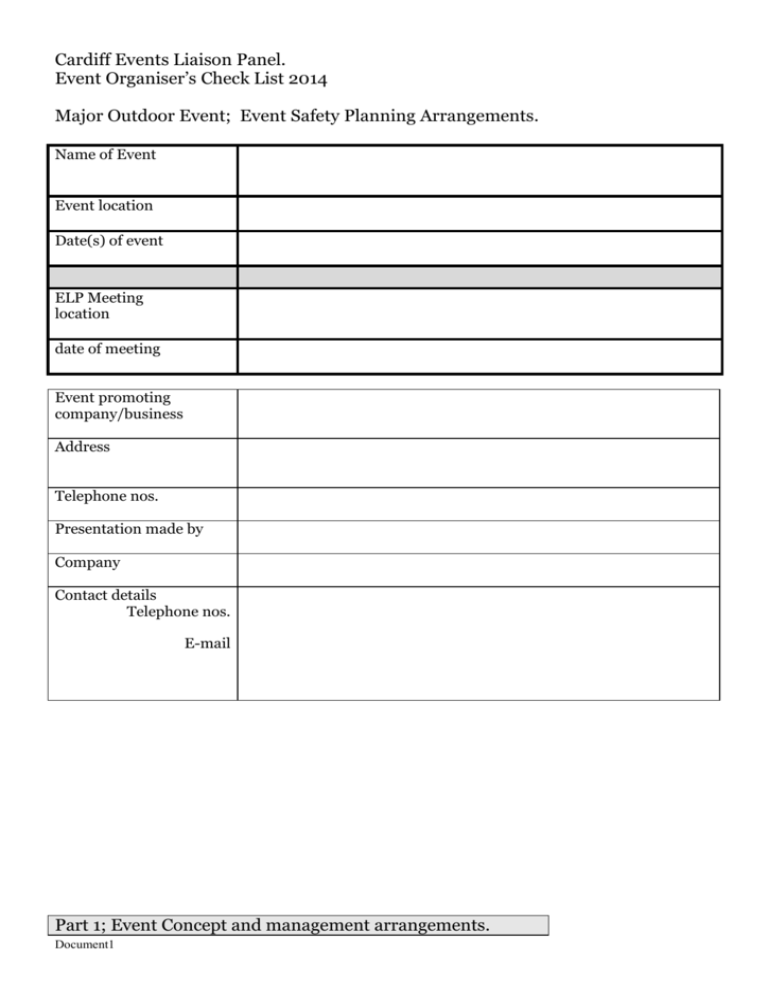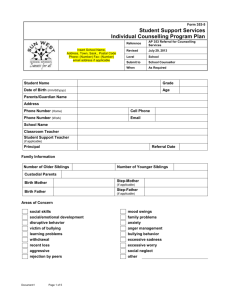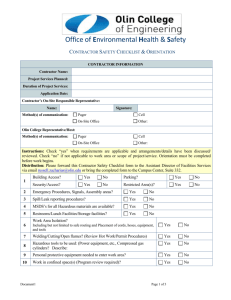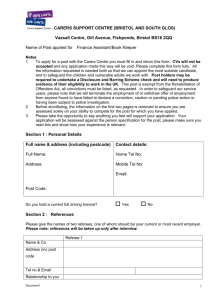Appendix A1 – Event Organiser CheckList 2014
advertisement

Cardiff Events Liaison Panel. Event Organiser’s Check List 2014 Major Outdoor Event; Event Safety Planning Arrangements. Name of Event Event location Date(s) of event ELP Meeting location date of meeting Event promoting company/business Address Telephone nos. Presentation made by Company Contact details Telephone nos. E-mail Part 1; Event Concept and management arrangements. Document1 1.1 Subject Concept contents type of event/ description no. of days time start time finish 1.2 Event management structure interval? promoter details, site manager safety officer, major partners site licensee, 1.3 Performance type & no. of performers special features crowd interaction previous performance 1.4 Attendees/public size m/f ratio age-group special factors seated 1.5 Ticketing nos. special guests pre-sale conditions exclusions Document1 comments Part 2; Site information and Event Infrastructure. 2.1 Subject Site descriptors contents comments area topography access/egress services 2.2 Site perimeter adjacent properties yes/no design criteria type extent loading 2.3 Access/egress access gates control/flow/size signage ticket checks/prechecks security checks Crowd PA 2.4 Temporary structures e.g Large marquees Stages Barriers Screens Lighting gantries Seating platforms Inflatables Document1 Temporary structures shall comply with the principles given in the guidance document “Temporary Demountable Structures” 3rd Edition published by the Institution of Structural Engineers. Detailed design calculations and drawings of each structure shall be submitted if requested. For large tents and marquees, contractor to be a member MUTAmarq or equivalent. For Inflatable structures, contractor to be a member of a relevant trade association (e.g. AIMODS, NAIH or BIHA) and have had their equipment inspected under the PIPA or ADIPS inspection scheme. A safety certificate shall be provided for all temporary structures prior to use. A wind management plan shall be submitted and monitored by a competent person during the event. Structure Details (Give brief description of each) Name of Supplier Site information and Event Infrastructure [contd] 2.5 Subject electrical installation contents Installation designer? Installation contractor? Who will test, inspect and certify installation of above? Name of Certifier /Competence (NICEIC/ECA) Nominated person on site to supervise installation in use? Type of supply (generator / mains) Note:No petrol generators Detail of Installation (Drwg) If Event in Hours of darkness detail general site, escape and emergency lighting. Light level site inspection date. Exhibitors/catering units to have current certification. Certificates to be on site. All portable appliances including leads to have current PAT certification. How will compliance be achieved? Who will be responsible? What evidence will be on site? Are you providing on site test facility? 2.6 Health & Safety Safety Policies for 1. Event Organiser, 2. main contractors, 3. Event features, Risk Assessments for 1. Use of FLT’s 2. Work at heights Document1 comments 3. 4. 5. 6. 2.7 Water supply Description site construction, . . . List all intended use(s) of water Indicate the connection type (Mains, Private, Bowser or Tanker Supply?) Plans Risk Assessment Illustrate the water supply distribution network and indicate location of points of use (e.g. toilet, wash hand basins and showering facilities, drinking water points, food preparation). Provide a risk assessment of the water supply arrangements to: list and assess the potential risks at the site that may cause contamination of the water supply or an insufficient water supply the measures to be taken to control or prevent these risks the checks and monitoring procedures to be undertaken to ensure these control measures are in place e.g. sampling and on-going inspections actions to be taken should these control measures fail Emergency plan A method statement to describe: dealing with contamination incidents failure of water supply details of receiving & distributing other water supplies Disinfection Provide Certificates of Disinfection of all temporary pipes and fittings is advised to minimise contamination of the water supply. Sampling Water samples are taken to verify that all temporary pipes and fittings have been disinfected and the point of use water quality doesn’t present a risk to public health. Should the microbiological results be unacceptable, Pollution Control can advise on potential Document1 corrective action(s). Notes: 1. POLLUTION CONTROL can on request of the event organiser undertake the water sampling. The event organiser will have to pay a service charge and the laboratory analysis costs. Contact: Mr. Keri Lewis, Pollution Control, Cardiff Council, Room 204, City Hall, Cardiff, CF10 3ND Tel. 02920871676 E-mail: kelewis@cardiff.gov.uk 2. POLLUTION CONTROL will organise a joint inspection with DWR CYMRU WELSH WATER (DCWW) when the water supply distribution network is in place prior to the commencement of the event. In the case of a connection to mains water, as part of their regulatory duties DCWW will undertake an inspection to ensure the fixtures and fittings comply with The Water Supply (Water Fittings) Regulations 1999. 2.9 Drainage Disposal requirements Site Tanks Vehicle use. Part 3; Crowd Management Arrangements. 3.1 Subject Stewarding and security systems contents comments contractor(s) details SIA requirement? job descriptions. nos/locations control and communications. Liaison competence/training of providers. 3.2 Emergency plans Who is in command? Consider the key risks to the event and those people present. Communication methods at site and to emergency services Using the resources available to you onsite, develop emergency procedures to be followed by staff and volunteers in an emergency, e.g. a fire or structural failure. Have in place contingency plans to deal with incidents and situations as varied as overcrowding of part or all of the site, severe weather or power failure. jurisdiction/limits staged responses to an incident Document1 You will also need to consider your response to more serious emergencies, including major incidents that will require the help of the emergency services and where the situation is serious, hand over responsibility for the incident / emergency along with control of event stewards. control centre location An Emergency Plan should be produced and included in the overall event document that details your plans for the above with a quick outline here. Further information on emergency plans can be found via the link below; http://www.hse.gov.uk/event-safety/incidents-and-emergencies.htm 3.3 First aid/medical emergency contractor(s) details approval level of cover links to NHS posts/locations case recording 3.4 Fire Safety Fire Risk Assessment completed? Means for summoning Fire service Refer to: http://www.southwalesfire.gov.uk/English/business_fire_safety/Pages/default.a spx for risk assessment templates and CLG Guide No. 9 – open air events and venues Documented evacuation strategy/means of escape Adequate routes for on coming appliances fabric certification signage/lighting means for fighting fires/means of giving warning special risks eg disabled people or lone workers In the case of temporary structure identify the maximum no. of people that can enter the structure (based on floor space factor, numbers, size and position of exits) Crowd Management Arrangements.[contd.] 3.5 Subject contents Licensing Operating schedule, Underage drinking Excess sales Document1 comments Offers Drinking utensils, Drug Safety Policy 3.6 Transportation Transport Plan required? Public access/transport car/coach parking road closures/exemptions pedestrian routes drop off/pick up Part 4; Show production and Features. 4.1 Subject Noise Control contents contractor detail(s) sources type duration nuisance capacity control measures contact arrangements 4.2 Special effects contractor(s) details fireworks lasers/strobes, stage effects provided by 4.3 Show details timing/location Processions, Audience interaction, Over head activity Finale detail Document1 comments Part 5; Site facilities. 5.1 Subject Sanitary accommodation contents comments based on audience size nos/ratio/signage location type maintenance 5.2 Catering Contractor(s) details Crew VIP Public catering Concessions An Outdoor Catering Checklist is provided in Appendix 1 to help you ensure that your food business operates to the highest standards of hygiene throughout the event. This checklist is based upon the Chartered Institute of Environmental Health’s Guidelines for Outdoor Catering Events. You should work through the checklist and ensure that you have everything in place prior to the event. location(s) kitchen detail menu(s) Licensed service. License/restrictions queuing system Hand washing requirements for food businesses operating at events: Teal units with running water: all caterers; retailers of open high risk ready to eat foods such as meat pies, cheese, ice-cream, cooked meats and similar deli items, cooked shellfish, et al; retailers of raw meats/ fish/ poultry; all those providing tasters as there will be open foods and handling Bowl of water (must have access to hot water and be able to regularly replenish to avoid a bacteria soup): retailers of low risk open foods such as confectionary, breads, biscuits et al Communal access to hand wash facilities: retailers of all packaged foods where there is no unwrapping/ cutting and the product is sold wrapped and sealed as it arrived on site. All must have suitable antibac hand wash and a suitable means of drying hands such as disposable paper towels. Document1 5.3 Waste contractor detail(s) litter bulk on-site litter /bulk disposal contractor hazardous waste Provision of bins 5.4 Information services Recycling/Food waste meeting points child recovery welfare arrangements 5.5 disabled provision nos/identified accompanied viewing san/accom. monitoring Part 6; Other Local Information. 6.1 Subject relevant information contents other events adjacent property conflicting activities on site/off site local news 6.2 Get In/Get Out dates and times site security/separation traffic management 6.3 ELP activity liaison with site meeting daily debrief event appraisal Document1 comments site clearance event passes 6.4 other considerations Various groups on the ELP may be promoting certain event characteristics or carrying out specific investigations Nutritional food The Council’s Strategic Planning and Environment wishes to encourage and promote the availability of food which is wholesome and of high nutritional quality. Working at heights The Health and Safety Enforcement section of Strategic Planning and Environment will be monitoring site construction arrangements with particular reference to working at heights. Notes. Meeting Summary section 1 2 3 4 5 6 7 8 9 10 11 Document1 subject detail Action by 12 13 14 15 APPENDIX 1 The County Council of the City & County of Cardiff Public Protection Room 131 City Hall Cardiff CF10 3ND Tel: 02920 871120 / 02920 871128 Outdoor Catering Checklist The checklist is intended to help you ensure that your food business operates to the highest standards of hygiene throughout the event. This checklist is based upon the Chartered Institute of Environmental Health’s Guidelines for Outdoor Catering Events. You should work through the checklist and ensure that you have everything in place prior to the event. If you answer “No” to any of the questions, you must ensure that the matter, or potential problem, is addressed before the event takes place. Food Business Name: …………………………………………………………………………………. Event: …………………………………………………. Date: ………………………. Yes Food Safety Management System Have you developed a food safety management system for your outdoor catering? (e.g. Safer Food Better Business Pack). Your management system must be relevant to your food handling practices at the event. You must also ensure that you take this document with you to the event. Do you have a supply of monitoring sheets for use at the event? Food Handling Staff Are all of your food handlers (including temporary staff) adequately trained, supervised and given instruction in their expected duties? Document1 No Yes Do you have staff hygiene training records to verify the above? Evidence must be supplied. Have your staffs been given a supply of clean personal protective clothing to wear at the event? Staff must be provided with protective over-clothing. It is not acceptable for staff to handle/serve food in outdoor/everyday clothing. Do you have a supply of separate aprons for those staff engaged in raw food preparation? Disposable plastic aprons are recommended for raw food handling and preparation Are your staffs aware that they should not handle food if they are suffering from certain illnesses? They must be symptom-free for 48 hours if suffering from sickness and diarrhoea. Is your unit adequately protected from inclement weather? If not, you will need to consider what protection can be provided for the site in question Is your unit in good repair, capable of being cleaned and pest-proofed? Are all work surfaces and preparation tables sealed, or covered, with an impervious, washable material (e.g. stainless steel, formica, washable table cloth) Have you adequately protected the floor surface in your food preparation areas? Where the event is taking place on grass, it is not acceptable to operate without some form of washable floor covering. Do you have adequate refrigeration available, and as it capable of keeping high-risk foods below +8oC throughout the event? You must have good separation between raw and ready-to-eat foods at all times The use of cool boxes for storing high-risk foods for long periods of time is not recommended Do you have adequate freezer storage space available, and does it work properly? You must have good separation between raw and ready-to-eat foods at all times Do you have suitable equipment for cooking and hot holding your food? Food must be cooked above +75oC for 30 seconds (or equivalent) Food must be hot held above +63oC Do you have sufficient preparation space so that cross-contamination can be avoided? You must strive to have complete separation between areas used for preparing raw products (particularly meat) and ready-to-eat foods. Do you have colour-coded chopping boards that are in a good state of repair? Do you have separate, or colour-coded, utensils for both raw and ready-to-eat foods? Are there sufficient wash hand basins for your unit considering its size; number of staff and anticipated food handling practices? (NOTE: a bowl on its own is not acceptable as a wash hand basin. There must be an effective means of drainage into a waste water container from the wash hand basin). Where staffs are split between raw and ready-to-eat products, ideally there should be separate wash hand basins for each area. If not, there should at least be means of disinfecting the wash hand basin after raw food handlers have used it. Are the wash hand basins supplied with hot and cold running water? Using hot water directly from an urn or kettle is not recommended since staffs are unlikely to wash hands properly. Does your wash hand basin have a suitable waste water container? An open bucket is not suitable. The waste water container should have a screw neck on which a lid can be Document1 No Yes No screwed. Have you got an adequate supply of liquid anti-bacterial soap to last the whole event? Have you got an adequate supply of paper towels for hand drying? Cloth hand towels are not recommended NB: The use of disposable gloves at an event does not excuse businesses from hand washing. Gloves should be changed on a regular basis and hands should be washed each time gloves are changed. Do you have a large enough sink to accommodate all of your food equipment and utensils? Does your sink have an adequate supply of hot and cold running water? Does the waste water drain into a suitable container? Not an open bin or bucket. Have you got separate and suitable waste water containers? These must be clearly marked “waste water containers”. Have you got enough fresh water containers? These must be marked “fresh water only”. Are your fresh water containers clean? Fresh water containers must be disinfected using a Milton type solution and rinsed prior to use. They must also have caps on them to prevent contamination. Has your unit been thoroughly cleaned since your last event? Do you have an adequate supply of clean cloths? Ideally these should be disposable single use only cloths Do you have an adequate supply of food-safe sanitiser, or disinfectant, which complies with BS EN 1276 & BS EN 13697? It is recommended that you use pre-diluted, ready-to-use products. Your staff must also be aware of the minimum required contact time. Do you have lidded bins for food and other waste? Do you have arrangements for the collection and disposal of waste oil? Do you have a working digital probe thermometer? You must have one on site and it must be in good, clean condition and be working. Are sanitising probe wipes available to clean and disinfect the thermometer? Do you have a first aid box with brightly coloured plasters? (Usually blue – skin tone is not acceptable). Corrective action to be taken before the event takes place Document1 You are likely to receive a visit from one of the Food Safety Team Officers during the event. If any of the points described in this checklist have not been addressed, you may be instructed to temporarily close until corrective actions have been taken. If you are failing to control the risk of cross-contamination, or high-risk foods are not being maintained under proper temperature control, you will be instructed to close until the problem has been resolved. This may also require you to dispose of potentially contaminated food. You may wish to bring your completed checklist to the event to show the Officer what steps you have taken to ensure that your food is safe. Document1








